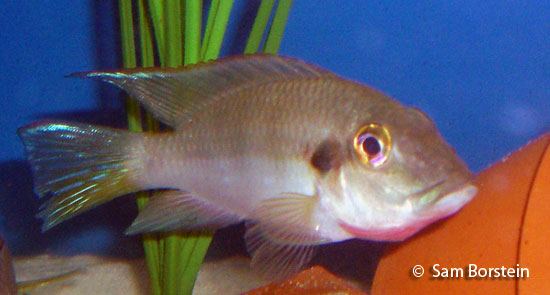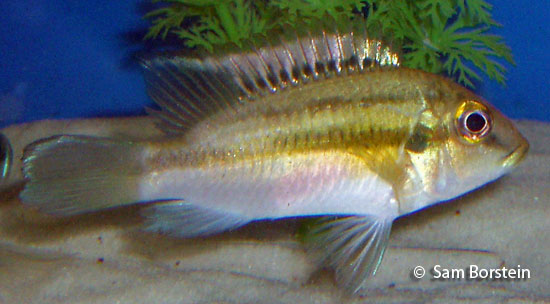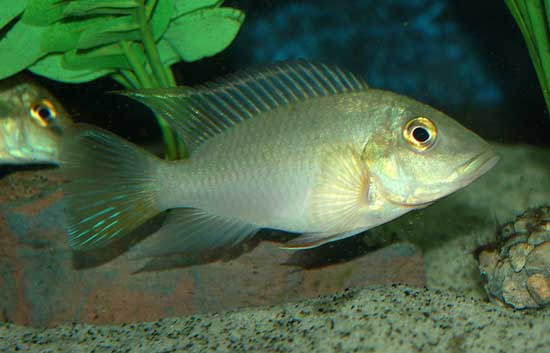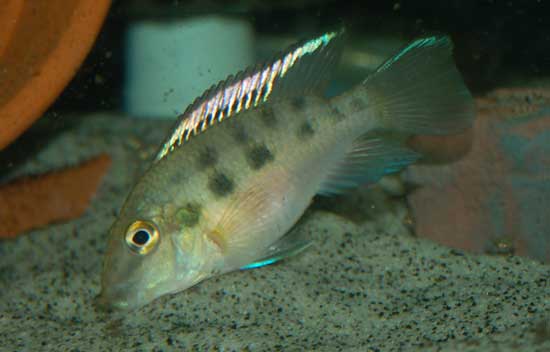Chromidotilapia guntheri guntheri
(Sauvage, 1882)
Gunther's Mouthbrooder
Synonyms: Chromidotilapia guntheri

Above: A male Chromidotilapia guntheri guntheri. Photo by Sam Borstein.
Etymology:
Genus- Chromis= color (Greek), tilapia= African for fish (Bechuana).
Species- guntheri= named after Albert Günther .
Subspecies- guntheri= named after Albert Günther .
Intro:
Chromidotilapia guntheri guntheri is a beautiful and extremely interesting West African Cichlid first typed by Sauvage in 1882. This mid-sized cichlid is easy to care for, interesting, and pretty. It also is a paternal mouthbrooder, so males hold the eggs. It is a surprise that this fish with all these pleasing characteristics is not more popular in the hobby.
This fish, which is a West African eartheater shows stunning color. The males get a bright red throat while females get a rosy Kribensis like belly and have an iridescent dorsal fin.
Chromidotilapia guntheri has 2 subspecies. The validity of them is in question and they may all be one species (Lamboj, 2004):
- Chromidotilapia guntheri guntheri- the fish most commonly encountered in the hobby.
- Chromidotilapia guntheri loennbergi- A fish similar to the above endemic to Lake Barombi-ba-Kotto. The fish has many black spots in the dorsal fin.
Distribution:
Chromidotilapia guntheri guntheri is found through the Niger River system and in some coastal countries of West Africa. They are found in both hard and soft waters and also in both basic and acid waters.
Size, Maturity, and Sexual Dimorphism:
Size: Males- 8 inches, Females- 5 inches
Maturity: 2.5 inches
Sexual Dimorphism: Males are larger than females and show more red on the throat region. Females get a rosy belly and chrome colored dorsal fin which is lacking in males.

Above: A female Chromidotilapia guntheri guntheri. Photo by Sam Borstein.
Care:
Chromidotilapia guntheri guntheri poses few problems when it comes to captive care. The fish do form pair and pairs can become territorial against other pairs. They will not harm other species unless they are spawning.
As far as tankmates, the fish can hold their own, but do best with passive fish in with them. There is a lot of different combinations you could do. Smaller and gentler mbuna as well as smaller West Africans work well. Tetras, barbs, and danios are also other good choices.
Chromidotilapia guntheri guntheri is very tolerant of water parameters and only the extremes should be avoided. Decorate the tank with rocks, slate, and other various hiding spots. Chromidotilapia guntheri guntheri is a eartheater, so a sand substrate is best.
Diet:
Chromidotilapia guntheri guntheri sifts the sand for edibles. In the wild it will eat almost anything it finds. In captivity it accepts almost any flake or pellet, but because of how the fish feed, it seems like sinking pellets are preferred.

Above: A Chromidotilapia guntheri guntheri sand sifting. Note the sand coming from the gills. Photo by Rick Borstein.
Breeding:
Once a pair forms the fish is easy to breed. The pairs generally have a strong pair bond and will breed every month or so. Generally before breeding, the male gets a brighter red in the throat and the female's colors brighten.

Above: A female Chromidotilapia guntheri guntheri in breeding condition. Photo by Rick Borstein.
What is cool about this fish is that it is a paternal mouthbrooder, meaning only the male will carry the eggs. The fish generally spawn on a piece of slate or in a flower pot and the male picks up the eggs. The fish are generally good holders and will hold for two weeks, a short period for a mouthbrooder.
Chromidotilapia guntheri guntheri are great parents. After the fry become free swimming, the female becomes more active in fry protection and both she and the male will allow fry back into their mouths and guard them viciously. The fry grow fast and by two months are close to an inch and a half. The best food for raising Chromidotilapia guntheri guntheri fry is baby brine shrimp and later crushed flake.
Conclusion:
Chromidotilapia guntheri guntheri is one of my favorite fish and I highly recommend them. If you like Geophagus, I recommend you try them. They are a very easy and peaceful fish to keep that displays interesting behavior. This is a hobbyist fish and can be difficult to obtain.
References:
- Lamboj, A. (2004). The Cichlid Fishes of Western Africa. Bergit Schmettkamp Verlag, Bornheim, Germany, 255 pp.
